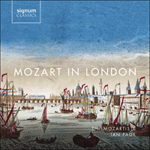
Welcome to Hyperion Records, a British classical label devoted to presenting high-quality recordings of music of all styles and from all periods from the twelfth century to the twenty-first.
Hyperion offers both CDs, and downloads in a number of formats. The site is also available in several languages.
Please use the dropdown buttons to set your preferred options, or use the checkbox to accept the defaults.

| The Mozartists, Ian Page (conductor)» More |
I am now in a spot outside the town, where I have been carried in a sedan-chair in order to develop a stronger appetite and renewed strength from the clean air. It has one of the most beautiful views in the world. Wherever I turn my eyes I see only countryside, and in the distance the finest castles, and the house in which I am living has a lovely garden.
The one drawback of this idyllic setting was that Wolfgang and Nannerl, on account of their father’s grave illness, were not allowed to make any noise, not even music. Nannerl was to recall in her memoirs many years later that 'our father lay dangerously ill; we were forbidden to touch the keyboard, and so, in order to occupy himself, Mozart composed his first symphony with all the instruments of the orchestra, especially trumpets and timpani'. Whether the work described by Nannerl is the symphony K16 is debatable (it does not call for trumpets or drums), but it is at any rate the first of Mozart’s symphonies to survive, and it certainly constitutes an auspicious arrival on the compositional scene for the young prodigy. In London he had already encountered an extremely cosmopolitan group of composers, headed by two Germans, Karl Friedrich Abel and Johann Christian Bach (son of the great Johann Sebastian), and the first symphony, which was probably first performed at a concert given by Wolfgang and Nannerl at the Little Theatre, Haymarket on 21 February 1765, shows how completely the young Mozart was able to assimilate and recreate each of the styles with which he came into contact.
Like the symphonies of Abel and Bach, it has three short movements (fast, slow, fast), and it captures the early symphonic vocabulary—alternations of loud and soft, tremolos, rapid scales—with remarkable confidence. Yet in the ethereal suspensions that immediately follow the opening unison fanfare there is already an originality and otherworldly beauty in the music, as well as the sense of an impetuous youth testing how far he can push and challenge the rules he has been taught. In the second movement, which similarly plays with texture and colour rather more than with melody, the first horn plays the same four-note pattern that twenty-four years later was to open the last movement of Mozart’s final symphony, the ‘Jupiter’; much significance has been made of this, but it is surely no more than a tidy coincidence.
The work concludes with a short but ebullient finale in which cascading violins and braying horns dominate. Some of the writing for second violins in particular is surprisingly taxing, and a brief unison figure in the strings explores chromaticism which would doubtless have raised a few eyebrows among early audiences. On the whole, however, this is an astonishingly accomplished and assured début, and the listener quickly forgets that this is the work of an eight-year-old—indeed no adjustment of expectation is required.
from notes by Ian Page © 2018
 Mozart in London Mozart in LondonMozart's Symphony No 1 was composed in Chelsea. It is here recorded alongside other early works and a panoply of the musical influences the eight-year-old genius would have enjoyed during his stay.» More |

